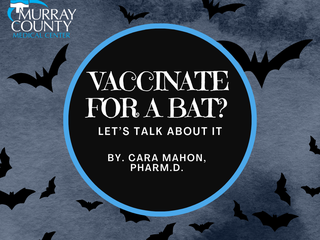Blog
Vaccinate for a Bat?

Let's talk about that!
Vaccinate for a Bat? Let’s talk about that!
Tis the season for human bat exposures. Late July to early September is the most common time of year for bats to be active and although they are mainly nocturnal animals and most active after sunset, this time of year is when we often see them entering homes, garages, and increasing their exposures to humans and pets.
What’s the big deal?
In the United States, bats are the most reported animal with rabies. Most people in the US who die of rabies were exposed to a rabid bat. Rabies is a serious, almost always fatal, viral disease.
Signs of Rabies in Bats?
- Active during the day
- Found in unusual places inside a home or on the ground
- Unable to fly
- Made contact with people as they typically avoid humans
What should you do if you encounter a bat?
- Avoid touching it
- Bat bites are tiny, and many wouldn’t know they’ve been bitten, even scratches from bats can risk exposure to rabies
- Call your local clinic or the MN department of health if you find a bat in your home. Do not release or kill the bat until you talk with a public health expert.
- If you were bitten or scratched by a bat, wash the wound well with soap and water and seek medical attention. If the saliva or brain material gets into your eyes, nose, mouth or an open wound seek medical attention urgently.
When should a bat be submitted for rabies testing?
- A person has been bitten or had physical contact with a bat
- A person wakes up to a bat in the room while they were sleeping
- A bat is found in a room with an unattended young child that cannot reliably report what happened
- A bat is found in a room with anyone who cannot reliably communicate whether there was physical contact
How to properly and safely capture a bat and submit it for testing
- Use a container with a lid. Do not use pillowcases, blankets or towels, as bats may bite through fabric.
- Wear heavy-duty or thick leather gloves. Bats can bite through gardening, latex gloves, or dish gloves.
- Wait for the bat to land. Approach the bat slowly and place the container over the bat. Then slide the lid (or a piece of cardboard) underneath the bat and flip the container over, trapping the bat inside.
- Secure the lid with tape. Create small breathing holes in the lid using scissors.
- Whenever possible, do not smash a bat with an object. The brain must remain intact for the bat to be tested for rabies, and it is easy to crush a bat’s skull.
- There is no need to kill the bat; the bat may be hand delivered alive to the Minnesota Veterinary Diagnostic Laboratory during normal business hours for testing or it may be euthanized by a veterinarian prior to submission.
- If the bat is dead, keep it cool in the refrigerator, but avoid freezing. If the bat has been inadvertently frozen, it is still worthwhile to submit it as many will still be testable.
- Whenever possible, deliver the bat in person to the Veterinary Diagnostic Laboratory, keeping it cool during transport. Hand delivery reduces the time to testing, which can be important for maintaining sample quality, especially during summer months.
- If hand delivery is not possible, you may contact a local veterinary clinic to euthanize the bat (if necessary), package it, and arrange for next-day delivery to the Veterinary Diagnostic Laboratory.
How can I be protected from Rabies?
- All potential bat exposures or bites are reviewed with the Minnesota Department of Health. Rabies vaccines and immune globulin are given to patients who require vaccination against rabies after review of the exposure on a case-by-case basis and after testing is completed if able. Vaccination against rabies is nearly 100% effective at preventing rabies if administered promptly.
- If you or someone you know has been bitten by a bat or was exposed to one, Murray County Medical Center can assist you with determining whether rabies post-exposure prophylaxis/vaccination is necessary.
Cara Mahon, Pharm.D.
Murray County Medical Center
References:
Minnesota Department of Health
Centers for Disease Control and Prevention (CDC)